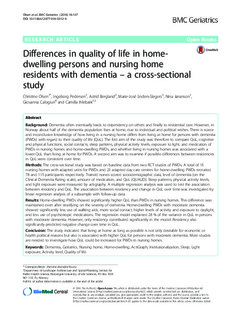| dc.description.abstract | Background: Dementia often eventually leads to dependency on others and finally to residential care. However, in
Norway about half of the dementia population lives at home, due to individual and political wishes. There is scarce
and inconclusive knowledge of how living in a nursing home differs from living at home for persons with dementia
(PWDs) with regard to their quality of life (QoL). The first aim of the study was therefore to compare QoL, cognitive
and physical functions, social contacts, sleep patterns, physical activity levels, exposure to light, and medication of
PWDs in nursing homes and home-dwelling PWDs, and whether living in nursing homes was associated with a
lower QoL than living at home for PWDs. A second aim was to examine if possible differences between residencies
in QoL were consistent over time.
Methods: The cross-sectional study was based on baseline data from two RCT studies of PWDs. A total of 15
nursing homes with adapted units for PWDs and 23 adapted day care centres for home-dwelling PWDs recruited
78 and 115 participants respectively. Trained nurses scored sociodemographic data, level of dementia (on the
Clinical Dementia Rating scale), amount of medication, and QoL (QUALID). Sleep patterns, physical activity levels,
and light exposure were measured by actigraphy. A multiple regression analysis was used to test the association
between residency and QoL. The association between residency and change in QoL over time was investigated by
linear regression analysis of a subsample with follow-up data.
Results: Home-dwelling PWDs showed significantly higher QoL than PWDs in nursing homes. This difference was
maintained even after stratifying on the severity of dementia. Home-dwelling PWDs with moderate dementia
showed significantly less use of walking aids, more social contact, higher levels of activity and exposure to daylight,
and less use of psychotropic medications. The regression model explained 28 % of the variance in QoL in persons
with moderate dementia. However, only residency contributed significantly in the model. Residency also
significantly predicted negative change over time in QoL.
Conclusion: The study indicated that living at home as long as possible is not only desirable for economic or
health political reasons but also is associated with higher QoL for persons with moderate dementia. More studies
are needed to investigate how QoL could be increased for PWDs in nursing homes | nb_NO |

